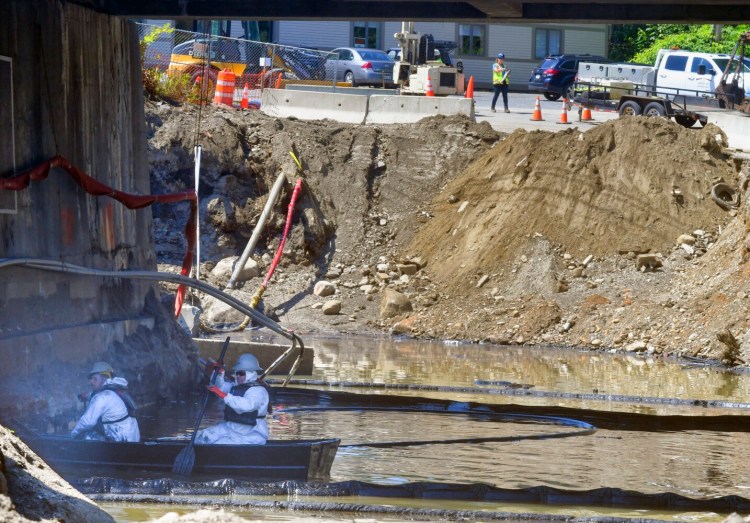GARDINER — More than six weeks after state environmental officials started supervising the cleanup of contaminated materials at the site of a bridge reconstruction project along Cobbosseecontee Stream, they are making plans to wrap it up.
But they may not have cleaned up all the pollution.
“I think we have gone as far as we could go,” David Madore, communications director for the state Department of Environmental Protection, said Friday. “We’re going to try to remove as much as we can and do what we can to contain the rest.”
To date, 3,700 tons of contaminated soil and 2,000 gallons of free product has been removed from the site.
For more than six weeks, contractors have been removing soil contaminated with No. 6 residual oil, the type of fuel that has been used in furnaces and boilers, from the right of way that runs under the Bridge Street bridge and from a site just upstream from the bridge.
At the outset, the project was anticipated to last a couple of weeks, but as more material was discovered, the DEP brought in a contractor in mid-August to complete geoprobe borings to try to identify where contamination is coming from.
Madore said a potential source has been identified in the former Chapman’s lot on Water Street, where Bridge Street becomes Brunswick Avenue. The Department of Transportation acquired that property earlier this year through eminent domain as part of a plant to improve the intersection on which it sits. In the mid-1940s, a gas station had been built on the site.
Another suspected source was the former Gardiner Shoe factory, which for decades stood on Water Street, just upstream from the Bridge Street bridge.
“We’ve got two weeks to do whatever we can,” Madore said. “Then we’ll have to stop because we are up against the Department of Transportation’s timeline.”
Like many New England cities and towns, Gardiner’s economic history was in industry. Cobbosseecontee Stream, thanks to its drop in elevation as it flows toward the Kennebec River in Gardiner, has several dams that were built for power generation, and mills and factories lined its banks for about 200 years.
The investigation was focused on a parcel of land adjacent to the site of the Gardiner Shoe Co. building, which was razed in 1971.
The Kennebec Journal reported then that the mill had been slated to come down by April 15, but due the winter’s severe storms, the date was delayed to May 15.
The demolition contractor, Chester Weymouth Sr., said in an interview published in the newspaper at the time that the building had “come down hard,” and characterized the job as gigantic. By his estimate, the building contained seven miles of radiation heating pipe, three miles of electrical conduit and about a half-million board feet of lumber, which had been sold.
The only thing Weymouth had trouble selling was the building’s 7-year-old, oil-fired steam boiler, he said.
At the time, Weymouth said he had not seen the sub basement that was reported to be under the main basement.
The U.S. Army Corps of Engineers was completing a flood prevention project at about the same time and it was rumored that the earth dike and sandbags would be used to fill the gap when that project ended.
The project to replace the Bridge Street and Maine Avenue bridges in Gardiner has been in the works for several years. The bridges, which cross Cobbosseecontee Stream at the north edge of Gardiner’s downtown, have reached the end of their useful lives.
The Department of Transportation routinely provides site assessments of its projects to the Department of Environmental Protection for review if contamination is suspected as part of a longstanding agreement between the two departments.
By the middle of August, the DEP had spent $400,000 on remediation. On Friday, Madore said the final cost will not be known until all the bills are tallied, but it could be about $800,000.
A project update issued by the DOT at the end of August noted DEP officials had applied for funding to continue cleanup work.
Madore said his department is not applying for more funds. Instead, it will use its own funds to cover the cost of cleanup.
While the U.S. Environmental Protection Agency had been contacted about the project, an agency spokesman based in Massachusetts said as of mid-August, the agency had not been asked to contribute to the cleanup.
Send questions/comments to the editors.




Comments are no longer available on this story